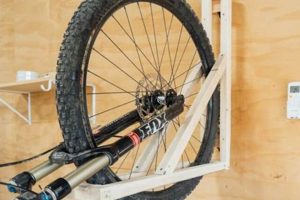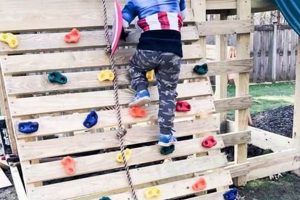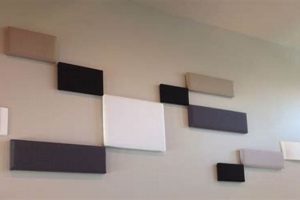A do-it-yourself climbing structure, typically constructed from wood and climbing holds, offers a customizable and accessible way to bring the challenge and enjoyment of rock climbing into a private or controlled environment. These structures can range from small, wall-mounted panels for training to larger, more elaborate freestanding formations. A home-built climbing surface, for instance, provides a readily available space for physical activity and skill development.
The advantages of constructing a climbing surface at home are multifaceted. It allows for personalized training regimens, adaptable to individual skill levels and physical limitations. The construction process also fosters problem-solving skills and spatial reasoning. Historically, individuals have sought to recreate natural rock formations for practice and recreation, leading to the development of artificial climbing walls and subsequently, the adoption of do-it-yourself approaches for creating these structures.
The subsequent discussion will delve into key considerations for planning and constructing a secure and engaging personal climbing area. This will include material selection, structural design principles, hold placement strategies, and safety protocols essential for responsible construction and use.
DIY Rock Wall
The construction and use of a climbing surface necessitates careful planning and adherence to safety guidelines. The following tips are designed to promote a structurally sound and enjoyable climbing experience.
Tip 1: Prioritize Structural Integrity: The foundational support of a climbing structure must be robust enough to withstand dynamic loads. Employ pressure-treated lumber or equivalent materials resistant to decay and insect damage. Reinforce joints with metal brackets and appropriate fasteners.
Tip 2: Implement a Grid System for Hold Placement: Establishing a consistent grid pattern across the climbing surface allows for systematic and adjustable hold arrangement. This facilitates route setting and enables the creation of diverse climbing challenges.
Tip 3: Select Climbing Holds Strategically: Opt for climbing holds manufactured from durable materials and designed for secure attachment. Consider a variety of hold shapes and sizes to accommodate different climbing styles and skill levels.
Tip 4: Ensure Adequate Padding: Impact absorption is paramount. Employ thick, closed-cell foam padding beneath and around the climbing area to mitigate the risk of injury from falls. Regularly inspect the padding for wear and tear.
Tip 5: Implement a Belay System: For climbing structures exceeding a certain height, a belay system is crucial. Ensure the belay anchor points are securely anchored to the structural framework and utilize certified belay devices and ropes.
Tip 6: Establish Clear Climbing Rules: Develop and enforce a set of climbing rules that emphasize safe practices. This should include guidelines on spotter positioning, maximum climber weight, and the proper use of equipment.
Tip 7: Conduct Regular Inspections: Routinely inspect the climbing structure, including the supports, holds, and padding, for any signs of damage or wear. Promptly address any issues to maintain the structural integrity and safety of the climbing surface.
Careful attention to structural design, hold selection, safety measures, and routine maintenance ensures a safe and rewarding experience.
The next section provides a summary of key considerations for maximizing the usability and lifespan of a climbing area.
1. Structural Integrity
Structural integrity forms the bedrock of any secure and functional climbing structure. In the context of a do-it-yourself climbing area, ensuring robust construction is not merely a matter of convenience; it is a critical safety imperative. The following facets highlight the key considerations regarding structural integrity.
- Load-Bearing Capacity
The climbing structure must be capable of withstanding the dynamic forces exerted during climbing. This necessitates accurate calculations of anticipated loads, accounting for climber weight, impact forces from falls, and the distribution of weight across the surface. Underestimation of these forces can lead to catastrophic failure. As an example, using undersized lumber or insufficient anchoring hardware compromises the entire structure.
- Material Selection and Durability
The choice of building materials directly affects the lifespan and safety. Pressure-treated lumber, steel, and other robust materials are essential to resist decay, insect infestation, and structural fatigue. Substituting cheaper, less durable materials risks premature degradation and potential collapse. For instance, untreated wood exposed to the elements will quickly deteriorate, rendering the climbing surface unsafe.
- Joint Reinforcement and Fasteners
The points where structural members connect are critical stress points. Properly reinforcing these joints with metal brackets, gussets, and appropriate fasteners is crucial. Using insufficient or improperly installed fasteners weakens the entire framework. An example of proper reinforcement involves using bolted connections with backing plates, distributing load effectively.
- Foundation and Anchoring
For freestanding climbing structures, the foundation must provide a stable and level base. Anchoring the structure to the ground or a building provides additional stability and prevents tipping. Failing to adequately anchor a structure, especially one with significant height, increases the risk of accidents. Concrete footings and properly sized anchors are vital for a secure foundation.
These facets underscore that structural integrity is paramount when constructing a personal climbing space. Adherence to sound engineering principles, meticulous material selection, and thorough construction practices are crucial for ensuring a safe and enjoyable experience for all users.
2. Hold Placement
Strategic placement of climbing holds on a do-it-yourself climbing wall directly influences the usability, challenge, and overall safety of the structure. The arrangement of these holds dictates the routes available to climbers, impacting the physical and technical demands of the activity.
- Route Difficulty and Grading
The spacing and orientation of holds determine the difficulty of a climbing route. Closely spaced holds generally create easier routes, while widely spaced or awkwardly angled holds increase the challenge. The principles of route grading, adapted from outdoor climbing, can be applied to home-built walls through deliberate hold arrangement. For instance, a route with numerous positive holds close together might be considered a beginner’s route (e.g., V0), whereas a route with sloping holds requiring dynamic movement could be graded as intermediate or advanced (e.g., V3+).
- Climbing Style and Technique
Different hold types and placements promote distinct climbing styles and techniques. Crimps (small, sharp holds) require precise finger strength, while slopers (large, rounded holds) demand body positioning and friction. Arranging a variety of hold types on a climbing wall encourages the development of diverse climbing skills. A section of the wall featuring predominantly crimps may necessitate a static climbing style, while another section with larger, more rounded features could promote dynamic movements and campusing techniques.
- Accessibility and Inclusivity
Thoughtful hold placement can create climbing routes suitable for a range of abilities and ages. Placing holds at varying heights and distances allows climbers of different sizes and skill levels to access the wall. Creating routes with alternative handholds accommodates climbers with physical limitations. For example, establishing routes with both larger, easier-to-grip holds and smaller, more challenging holds provides options for climbers of varying strength and experience.
- Safety Considerations
Improper hold placement can increase the risk of injury. Overly strenuous or awkwardly positioned holds can lead to strains or falls. Ensuring that holds are securely fastened to the wall and regularly inspected is essential for preventing accidents. Furthermore, avoiding placements that encourage awkward body positions or excessive reach minimizes the potential for injuries. The arrangement should always prioritize accessibility and safety over extreme difficulty, especially for inexperienced climbers.
Therefore, hold placement on a DIY climbing wall is not merely an aesthetic consideration but a fundamental element that shapes the climbing experience, influences skill development, and directly affects safety. Diligent planning and careful execution are essential to maximizing the potential of a home-built climbing area.
3. Safety Protocols
The implementation of rigorous safety protocols is paramount in the context of a do-it-yourself climbing structure. Due to the inherent risks associated with climbing, a proactive approach to safety is not merely advisable, but essential for mitigating potential injuries and ensuring a secure environment.
- Pre-Climb Inspection
A thorough inspection of the climbing structure before each use is a critical safety measure. This includes verifying the integrity of the climbing holds, checking for loose or damaged hardware, and assessing the condition of the padding or flooring beneath the wall. Any deficiencies identified must be rectified before climbing is permitted. For example, a loose climbing hold could rotate unexpectedly, leading to a fall. Regular inspection and maintenance prevent such incidents.
- Spotting Techniques
Effective spotting techniques are crucial for minimizing the risk of injury during falls. A spotter positions themselves to guide a falling climber safely to the ground, reducing the impact force and preventing uncontrolled landings. The spotter focuses on directing the climber’s torso and head away from potential hazards. Incorrect spotting, such as failing to maintain focus or positioning oneself too close to the wall, can exacerbate the risk of injury.
- Fall Zone Management
A clearly defined and unobstructed fall zone is essential for a safe climbing area. This zone should be free of any obstacles, such as furniture, tools, or other equipment, that could pose a hazard during a fall. The surface within the fall zone should be adequately padded with impact-absorbing materials. For instance, replacing a concrete floor with thick foam padding significantly reduces the likelihood of injuries from falls.
- Age and Skill Level Considerations
Climbing activities should be tailored to the age and skill level of the participants. Children and novice climbers require closer supervision and instruction. Routes should be selected or modified to match their capabilities, avoiding overly strenuous or technically challenging climbs. Enforcing limitations based on age and skill level minimizes the risk of accidents caused by exceeding one’s physical or technical abilities.
These facets emphasize the interconnectedness of safety protocols and the overall functionality of a climbing structure. Adherence to these guidelines fosters a secure environment, allowing individuals to engage in climbing activities with a reduced risk of injury.
4. Material Selection
Material selection exerts a profound influence on the safety, durability, and overall usability of any do-it-yourself climbing structure. The choice of materials directly impacts the structure’s capacity to withstand dynamic forces, resist environmental degradation, and provide a secure climbing surface.
- Structural Framing Materials
The primary structural framework, typically constructed from wood or steel, determines the load-bearing capacity of the climbing wall. Pressure-treated lumber, known for its resistance to decay and insect infestation, is a common choice for wooden frames. Steel frameworks offer superior strength and durability but require welding and fabrication skills. Using substandard framing materials compromises the structural integrity of the climbing wall, increasing the risk of collapse or failure under load. As an example, utilizing untreated softwood in an outdoor climbing structure will lead to rapid deterioration and potential safety hazards.
- Climbing Surface Panels
The panels affixed to the structural frame provide the climbing surface. Plywood, oriented strand board (OSB), and specialized climbing wall panels are common choices. Plywood offers a balance of strength and affordability, while OSB provides a more economical option. Specialized climbing wall panels, often constructed from composite materials, offer enhanced durability and texture. The type of panel selected affects the grip of the climbing holds and the overall aesthetics of the wall. For instance, a smooth plywood surface may require additional texturing to improve grip and prevent slipping.
- Climbing Holds
Climbing holds, manufactured from plastic or resin, are crucial for creating handholds and footholds. The material composition and design of the holds influence their grip, durability, and resistance to wear. High-quality holds provide a secure and comfortable grip, while inferior holds may crack, break, or become slippery over time. Selecting holds with appropriate size and shape is also important for creating diverse and challenging climbing routes. Using holds that are too small or sharp can increase the risk of finger injuries and fatigue.
- Fasteners and Hardware
The selection of fasteners and hardware, including bolts, screws, and T-nuts, is essential for securing the structural frame, attaching the panels, and mounting the climbing holds. Using high-strength fasteners and corrosion-resistant hardware ensures the long-term integrity of the climbing wall. Improperly sized or installed fasteners can weaken the structure and lead to safety hazards. For example, using undersized screws to attach climbing holds to the panels can cause the holds to pull out under load, resulting in a fall.
In summary, careful consideration of material properties and selection criteria is paramount for ensuring the safety, durability, and functionality of a do-it-yourself climbing wall. Compromising on material quality can lead to structural weaknesses, increased maintenance requirements, and elevated risk of injury. The investment in appropriate materials represents a critical component of a successful and long-lasting climbing structure.
5. Climbing Angle
The inclination of a climbing surface, commonly referred to as the climbing angle, exerts a substantial influence on the physical demands and technical challenges presented by a do-it-yourself climbing structure. A steeper angle increases the difficulty, requiring greater strength and more precise footwork. Conversely, a less inclined surface provides a more accessible environment for beginners and allows for the development of fundamental climbing skills. The selection of an appropriate angle is, therefore, crucial to the overall usability and safety of a home-built climbing wall. For example, a vertical wall (90 degrees) is generally suitable for introductory climbing, while a wall with an overhanging angle (greater than 90 degrees) necessitates advanced techniques and significant upper body strength.
The cause-and-effect relationship between angle and difficulty can be further illustrated by considering the distribution of weight during climbing. On a vertical surface, a climber’s weight is primarily supported by their feet, allowing for efficient movement and prolonged climbing sessions. As the angle increases, the climber’s weight shifts towards their hands, requiring greater muscular effort to maintain position. This increased strain necessitates the implementation of specialized techniques, such as “flagging” and “heel hooking,” to maintain balance and conserve energy. The practical significance of understanding this relationship lies in the ability to customize the climbing experience to individual skill levels and training goals. A home climbing structure incorporating adjustable angles allows for progressive difficulty increases as the climber’s proficiency improves.
In conclusion, the climbing angle serves as a critical parameter in the design and construction of a do-it-yourself climbing wall. Its careful consideration allows for the creation of a safe, challenging, and adaptable training environment. Challenges related to angle selection include accurately assessing the target user’s skill level and accommodating multiple skill levels within a single structure. Addressing these challenges through adjustable wall designs or the construction of multiple walls with varying angles ensures that the home climbing structure remains a valuable and engaging resource for climbers of all abilities.
6. Padding System
The functionality of a do-it-yourself climbing structure hinges significantly on the effectiveness of its integrated padding system. The climbing surface itself provides the means for ascent, yet the padding system is essential for mitigating the risk of injury from falls. A well-designed system absorbs impact energy, reducing the potential for fractures, sprains, and other trauma. For example, the application of thick, closed-cell foam pads beneath and around the base of a wall serves as a direct countermeasure to the forces generated during a fall. Without adequate padding, even a short fall can result in significant harm. Thus, the selection and installation of padding constitutes a primary safety consideration in the construction of a personal climbing area.
The configuration of a padding system necessitates consideration of factors such as fall height, anticipated fall direction, and climber weight. Padding material thickness, density, and coverage area all contribute to its effectiveness. Strategically positioned padding can safeguard against impacts with the ground, the climbing wall structure itself, or other surrounding objects. A comprehensive system may incorporate multiple layers of foam with varying densities to optimize energy absorption. Moreover, the padding system should extend beyond the immediate climbing area to account for unpredictable fall trajectories. As an illustration, commercial climbing gyms often utilize thick crash pads that overlap to eliminate gaps and provide a continuous protective surface.
In conclusion, a properly engineered padding system is not merely an adjunct to a do-it-yourself climbing structure, but an integral component that directly influences user safety. Neglecting or underestimating the importance of padding creates an environment of unacceptable risk. The challenges associated with implementing an effective padding system primarily involve balancing cost, space constraints, and the desired level of protection. Overcoming these challenges through informed material selection and careful installation ensures that a climbing area remains a safe and rewarding space for physical activity.
7. Route Setting
Route setting is an integral, dynamic component of a do-it-yourself climbing wall, transforming a static structure into an evolving physical and mental challenge. The arrangement of climbing holds dictates the path a climber takes, defining the difficulty, style, and technical demands of each ascent. On a fixed, home-built structure, route setting becomes even more crucial, as it is the primary means of introducing variety and preventing stagnation. For example, a simple change in the orientation or spacing of holds can dramatically alter the grade of a problem, offering new challenges without requiring structural modifications. Understanding the principles of route setting, therefore, directly impacts the long-term usability and value of a self-constructed climbing area.
The practical applications of effective route setting extend beyond simply creating climbs of varying difficulty. It provides a platform for targeted training, allowing climbers to focus on specific weaknesses or refine particular techniques. A setter can intentionally design routes that emphasize balance, power, or endurance, catering to individual training needs. Furthermore, creative route setting fosters problem-solving skills. Climbers must analyze the sequence of holds, identify efficient movement patterns, and adapt their approach based on their strengths and limitations. A well-set route becomes a puzzle to be solved, engaging both the body and the mind. This engagement is evident in gyms and home setups alike, where climbers will spend hours trying different beta (sequences of moves) on a single route.
In conclusion, route setting is indispensable to a do-it-yourself climbing wall, driving its adaptability and long-term appeal. The ability to create and modify routes allows for personalized training and prevents the structure from becoming a static, uninspiring exercise tool. Challenges in this domain include acquiring the knowledge and experience to set diverse and engaging routes and investing in a sufficiently varied collection of climbing holds. However, overcoming these challenges unlocks the full potential of a climbing space, ensuring it remains a stimulating and effective training environment.
Frequently Asked Questions
The following section addresses common inquiries concerning the construction and usage of do-it-yourself climbing structures. These questions aim to clarify essential aspects of safety, design, and maintenance.
Question 1: What are the fundamental safety requirements for a personal climbing structure?
Adherence to structural integrity guidelines is paramount. This encompasses appropriate load-bearing capacity, secure anchor points, and the implementation of a comprehensive padding system.
Question 2: What materials are suitable for construction?
Pressure-treated lumber, steel, and durable climbing holds are recommended. Untreated wood and substandard hardware are discouraged due to safety concerns.
Question 3: How should climbing holds be placed to optimize safety and challenge?
Hold placement should consider varying skill levels, climbing styles, and potential fall zones. Holds should be securely fastened and inspected regularly.
Question 4: What type of padding is appropriate for minimizing injury risk?
Closed-cell foam padding of sufficient thickness and coverage is essential. The padding should extend beyond the climbing area to account for unpredictable falls.
Question 5: What routine maintenance is required to ensure the longevity of a climbing structure?
Regular inspections for loose holds, damaged hardware, and wear on padding are necessary. Prompt repairs and replacements are crucial.
Question 6: Is prior climbing experience necessary to build and use a personal climbing wall safely?
While not mandatory, familiarity with climbing techniques and safety protocols is highly recommended. Novices should seek guidance from experienced climbers or qualified instructors.
Addressing these questions contributes to the safe and effective implementation of climbing spaces.
The next discussion will delve into case studies of climbing wall designs, illustrating practical applications of the principles outlined above.
DIY Rock Wall
This exploration of the do-it-yourself climbing structure encompasses design considerations, safety implementations, and maintenance demands. The long-term value and viability of a personal climbing area rest on adherence to established practices. Structural integrity, thoughtful hold placements, and rigorously enforced safety protocols are not merely suggestions but rather essential elements of a functional space. Selecting appropriate materials ensures long-term durability, minimizing the risks from wear and the consequences of failure.
The construction of a climbing surface necessitates careful planning. Ignoring details increases the risk to users. This structure can be a place of fun, challenge, and fitness, but only if every precaution is considered. The responsibilities involved must be understood before one considers creating a DIY rock wall.







